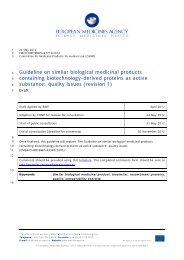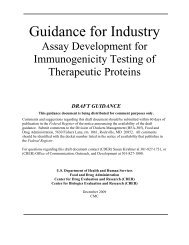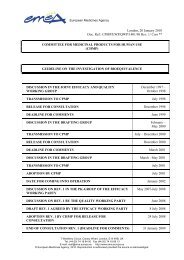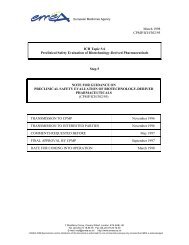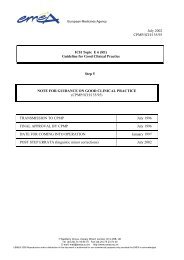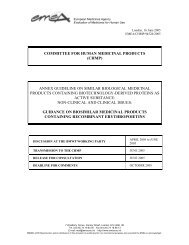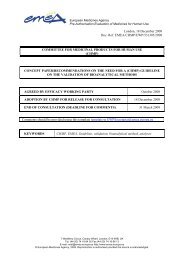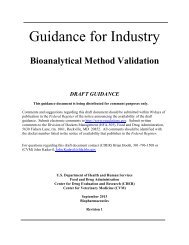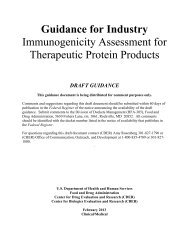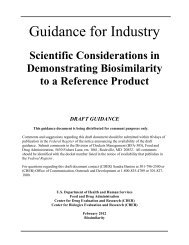EMA Guideline on immunogenicity assessment of biotechnology-derived therapeutic proteins
GUIDELINE ON IMMUNOGENICITY ASSESSMENT OF BIOTECHNOLOGY-DERIVED THERAPEUTIC PROTEINS, 2007 http://www.ipm-biotech.de/fileadmin/user_upload/pdf/guidelines/5-EMA-Immunogenicity-Assessment-2007.pdf
GUIDELINE ON IMMUNOGENICITY ASSESSMENT OF BIOTECHNOLOGY-DERIVED THERAPEUTIC PROTEINS, 2007
http://www.ipm-biotech.de/fileadmin/user_upload/pdf/guidelines/5-EMA-Immunogenicity-Assessment-2007.pdf
Create successful ePaper yourself
Turn your PDF publications into a flip-book with our unique Google optimized e-Paper software.
European Medicines Agency<br />
L<strong>on</strong>d<strong>on</strong>, 24 January 2007<br />
Doc. Ref. EMEA/CHMP/BMWP/14327/2006<br />
COMMITTEE FOR MEDICINAL PRODUCTS FOR HUMAN USE<br />
(CHMP)<br />
DRAFT<br />
GUIDELINE ON IMMUNOGENICITY ASSESSMENT OF BIOTECHNOLOGY-DERIVED<br />
THERAPEUTIC PROTEINS<br />
DRAFT AGREED BY BMWP July 2006<br />
ADOPTION BY CHMP FOR RELEASE FOR CONSULTATION 24 January 2007<br />
END OF CONSULTATION (DEADLINE FOR COMMENTS) 31 July 2007<br />
Comments should be provided electr<strong>on</strong>ically in word format using this template to:<br />
BMWP.secretariat@emea.europa.eu<br />
KEYWORDS<br />
Immunogenicity, <strong>biotechnology</strong> <strong>derived</strong> <strong>proteins</strong>, antigenicity risk factors,<br />
assays, clinical efficacy<br />
7 Westferry Circus, Canary Wharf, L<strong>on</strong>d<strong>on</strong>, E14 4HB, UK<br />
Tel. (44-20) 74 18 84 00 Fax (44-20) 74 18 86 13<br />
E-mail: mail@emea.europa.eu http://www.emea.europa.eu<br />
©EMEA 2007 Reproducti<strong>on</strong> and/or distributi<strong>on</strong> <strong>of</strong> this document is authorised for n<strong>on</strong> commercial purposes <strong>on</strong>ly provided the EMEA is acknowledged
GUIDELINE ON IMMUNOGENICITY ASSESSMENT OF BIOTECHNOLOGY-DERIVED<br />
THERAPEUTIC PROTEINS<br />
TABLE OF CONTENTS<br />
EXECUTIVE SUMMARY................................................................................................................... 3<br />
1. INTRODUCTION......................................................................................................................... 3<br />
2. SCOPE............................................................................................................................................ 3<br />
3. LEGAL BASIS .............................................................................................................................. 3<br />
4. MAIN GUIDELINE TEXT .......................................................................................................... 4<br />
REFERENCES .................................................................................................................................... 13<br />
©EMEA 2007 Page 2/17
EXECUTIVE SUMMARY<br />
Biological/<strong>biotechnology</strong>-<strong>derived</strong> <strong>proteins</strong> are increasingly used as <strong>therapeutic</strong> agents. These products<br />
may induce an unwanted immune resp<strong>on</strong>se in treated patients, which can be influenced by various<br />
factors, including patient-/disease-related factors and product-related factors.<br />
The c<strong>on</strong>sequences <strong>of</strong> such immune reacti<strong>on</strong>s to a <strong>therapeutic</strong> protein, range from transient appearance<br />
<strong>of</strong> antibodies without any clinical significance to severe life threatening c<strong>on</strong>diti<strong>on</strong>s.<br />
The predictive value <strong>of</strong> animal models for evaluati<strong>on</strong> <strong>of</strong> <strong>immunogenicity</strong> is low due to inevitable<br />
<strong>immunogenicity</strong> <strong>of</strong> human <strong>proteins</strong> in animals. N<strong>on</strong>-clinical studies may c<strong>on</strong>tribute to the<br />
interpretati<strong>on</strong> <strong>of</strong> comparability <strong>of</strong> the <strong>immunogenicity</strong> potential and <strong>of</strong> repeat dose toxicity studies.<br />
It is essential to adopt an appropriate strategy for the development <strong>of</strong> adequate screening and<br />
c<strong>on</strong>firmatory assays to measure an immune resp<strong>on</strong>se against a <strong>therapeutic</strong> protein. Assays should be<br />
capable <strong>of</strong> distinguishing neutralizing from n<strong>on</strong>-neutralizing antibodies, be validated and standardised.<br />
In the clinical setting, careful planning <strong>of</strong> <strong>immunogenicity</strong> evaluati<strong>on</strong> should include data<br />
systematically collected from a sufficient number <strong>of</strong> patients. The sampling schedule for<br />
<strong>immunogenicity</strong> evaluati<strong>on</strong> should be standardized, adapted for each product <strong>on</strong> a case-by-case basis<br />
and taking a risk-based approach. Data <strong>on</strong> the impact <strong>on</strong> efficacy and safety should be collected in<br />
order to fully understand the clinical c<strong>on</strong>sequences <strong>of</strong> the immune resp<strong>on</strong>se. Immunogenicity issues<br />
should be further addressed in the Risk Management Plan.<br />
1. INTRODUCTION<br />
Biological/<strong>biotechnology</strong>-<strong>derived</strong> <strong>proteins</strong> are increasingly used as <strong>therapeutic</strong> agents. It has been<br />
recognised that these <strong>proteins</strong> may induce humoral and cellular immune resp<strong>on</strong>ses.<br />
The c<strong>on</strong>sequences <strong>of</strong> an immune reacti<strong>on</strong> to a <strong>therapeutic</strong> protein range from transient appearance <strong>of</strong><br />
antibodies without any clinical significance to severe life threatening c<strong>on</strong>diti<strong>on</strong>s. Potential clinical<br />
c<strong>on</strong>sequences are severe hypersensitivity-type reacti<strong>on</strong>s, decrease in efficacy and inducti<strong>on</strong> <strong>of</strong><br />
autoimmunity, including antibodies to the endogenous form <strong>of</strong> the protein.<br />
Many factors may influence the <strong>immunogenicity</strong> <strong>of</strong> <strong>therapeutic</strong> <strong>proteins</strong>. They can be c<strong>on</strong>sidered to be<br />
patient-, disease- or product-related. Patient-related factors that might predispose to an immune<br />
resp<strong>on</strong>se include: underlying disease, genetic background, immune status, including<br />
immunomodulating therapy. Product-related factors also influence the likelihood <strong>of</strong> an immune<br />
resp<strong>on</strong>se, e.g. intensity <strong>of</strong> treatment (route <strong>of</strong> administrati<strong>on</strong>, source <strong>of</strong> protein, manufacturing process<br />
(impurity pr<strong>of</strong>ile, c<strong>on</strong>taminants), formulati<strong>on</strong> and stability characteristics (degradati<strong>on</strong> products,<br />
aggregates) <strong>of</strong> a given protein and dose, dosing interval and durati<strong>on</strong> <strong>of</strong> treatment).<br />
Although data <strong>on</strong> possible unwanted immune reacti<strong>on</strong>s to <strong>therapeutic</strong> <strong>proteins</strong> are required before<br />
authorisati<strong>on</strong>, problems may still be encountered in the post-authorisati<strong>on</strong> period. In the marketing<br />
authorisati<strong>on</strong> applicati<strong>on</strong>, the applicant should include a summary <strong>of</strong> investigati<strong>on</strong>s <strong>of</strong> <strong>immunogenicity</strong><br />
in the overview with full cross-reference to the data in the relevant modules.<br />
2. SCOPE<br />
The principles adopted and explained in this document apply <strong>proteins</strong> and polypeptides, their<br />
derivatives, and products <strong>of</strong> which they are comp<strong>on</strong>ents, e.g., c<strong>on</strong>jugates. These <strong>proteins</strong> and<br />
polypeptides are produced from recombinant or n<strong>on</strong>-recombinant cell-culture expressi<strong>on</strong> systems.<br />
For coagulati<strong>on</strong> factors, please, refer to the specific CHMP guidelines in this area.<br />
3. LEGAL BASIS<br />
This guideline has to be read in c<strong>on</strong>juncti<strong>on</strong> with the introducti<strong>on</strong> and general principles (4) and part<br />
III <strong>of</strong> the Annex I to Directive 2001/83 as amended.<br />
©EMEA 2007 Page 3/17
4. MAIN GUIDELINE TEXT<br />
4.1 Risk factors for developing an immune resp<strong>on</strong>se against a <strong>therapeutic</strong> protein<br />
4.1.1 Patient- and disease-related risk factors<br />
Patient-related factors, which might influence the immune resp<strong>on</strong>se to a <strong>therapeutic</strong> protein, may<br />
include, genetic factors, age <strong>of</strong> the patient, disease related factors including other treatments and<br />
previous exposure to similar <strong>proteins</strong>.<br />
Genetic factors<br />
• Genetic factors modulating the immune resp<strong>on</strong>se<br />
Genetic factors can alter the immune resp<strong>on</strong>se to a <strong>therapeutic</strong> protein and lead to inter-patient<br />
variability. Certain allelic loci in the major histocompatibility complex and strength or time <strong>of</strong> the<br />
MHC interacti<strong>on</strong> influence immune resp<strong>on</strong>ses and tolerance inducti<strong>on</strong>.<br />
Immune resp<strong>on</strong>ses may occur even if the amino acid sequence <strong>of</strong> the <strong>therapeutic</strong> protein is fully<br />
human.<br />
Other genetic factors influencing <strong>immunogenicity</strong> are gene polymorphisms for cytokines that play a<br />
role in the fine-tuning <strong>of</strong> the immune resp<strong>on</strong>se (e.g. interleukin-10, TGF-beta etc.).<br />
• Genetic factors related to a gene defect<br />
If the <strong>therapeutic</strong> protein is used for substituti<strong>on</strong>, reduced levels or even lack <strong>of</strong> endogenous protein<br />
influence immunological tolerance, since for these patients the physiological antigen may represent a<br />
neo-antigen.<br />
Age<br />
The data from <strong>on</strong>e age group cannot necessarily be projected to others since immune resp<strong>on</strong>se against<br />
a <strong>therapeutic</strong> protein can be an age-related phenomen<strong>on</strong>. Children may possibly have a different<br />
immune resp<strong>on</strong>se to these <strong>proteins</strong>. If the product is indicated in children studies <strong>on</strong> <strong>immunogenicity</strong><br />
should be carried out in this age group.<br />
Disease-related factors<br />
The patient’s underlying disease itself can be an important factor in the c<strong>on</strong>text <strong>of</strong> <strong>immunogenicity</strong>. It<br />
is possible that patients with autoimmune disease, i.e. with an immune system pr<strong>on</strong>e to altered<br />
immunological tolerance to self-<strong>proteins</strong>, may react differently.<br />
Some patients with chr<strong>on</strong>ic infecti<strong>on</strong>s may be more pr<strong>on</strong>e to an immune resp<strong>on</strong>se, since their immune<br />
system is in an activated state.<br />
In severe c<strong>on</strong>diti<strong>on</strong>s (i.e. malnutriti<strong>on</strong>, advanced metastatic disease, organ failure), an immune<br />
resp<strong>on</strong>se against a <strong>therapeutic</strong> protein might be less likely to occur due to an impaired immune system.<br />
For some products, it has been reported that the susceptibility to an antibody resp<strong>on</strong>se can be different<br />
for different indicati<strong>on</strong>s. Therefore, <strong>immunogenicity</strong> may need to be studied separately for each<br />
disease.<br />
C<strong>on</strong>comitant treatment<br />
C<strong>on</strong>comitant therapies may either decrease or increase the risk <strong>of</strong> an immune resp<strong>on</strong>se to a <strong>therapeutic</strong><br />
protein. Typically, the immune reacti<strong>on</strong> against a <strong>therapeutic</strong> protein is reduced when<br />
immunosuppressive agents are used c<strong>on</strong>comitantly. C<strong>on</strong>siderati<strong>on</strong> should also be given to previous<br />
treatments, that can modulate the immune reacti<strong>on</strong> to a <strong>therapeutic</strong> protein and that have a l<strong>on</strong>g-term<br />
impact <strong>on</strong> the immune system. If clinical trials are performed in combinati<strong>on</strong> with<br />
immunosuppressants, a claim for use <strong>of</strong> the <strong>therapeutic</strong> protein in m<strong>on</strong>otherapy must be accompanied<br />
by adequate clinical data <strong>on</strong> the <strong>immunogenicity</strong> pr<strong>of</strong>ile in m<strong>on</strong>otherapy.<br />
C<strong>on</strong>comitant therapies can also promote the immune resp<strong>on</strong>se to a <strong>therapeutic</strong> protein.<br />
©EMEA 2007 Page 4/17
• Durati<strong>on</strong>, route <strong>of</strong> administrati<strong>on</strong>, treatment modalities<br />
Factors, which may increase the immune resp<strong>on</strong>se to a <strong>therapeutic</strong> protein, may be the route <strong>of</strong><br />
administrati<strong>on</strong>, dose, and the schedule <strong>of</strong> administrati<strong>on</strong>.<br />
Products given intravenously may be less immunogenic than those given subcutaneously or<br />
intramuscularly.<br />
Treatment for a short time <strong>on</strong>ly is usually less likely to be associated with formati<strong>on</strong> <strong>of</strong> antibodies than<br />
l<strong>on</strong>g-term treatment, and products given c<strong>on</strong>tinuously are usually less immunogenic than those given<br />
intermittently.<br />
Intermittent treatment or re-exposure after a l<strong>on</strong>g treatment free interval may be associated with an<br />
increase in <strong>immunogenicity</strong>.<br />
• Previous exposure to similar <strong>proteins</strong><br />
Previous exposure to similar <strong>proteins</strong> can lead to pre-sensitisati<strong>on</strong> and cause an immune resp<strong>on</strong>se. For<br />
certain <strong>proteins</strong> being used for replacement therapy, previous therapies may have induced crossreacting<br />
antibodies that affect subsequent therapies.<br />
4.1.2. Product related risk factors <strong>of</strong> <strong>immunogenicity</strong><br />
Product-related factors influencing the <strong>immunogenicity</strong> <strong>of</strong> biological/<strong>biotechnology</strong>-<strong>derived</strong><br />
<strong>therapeutic</strong> <strong>proteins</strong> include the origin and nature <strong>of</strong> the active substance (structural homology, post<br />
translati<strong>on</strong>al modificati<strong>on</strong>s), modificati<strong>on</strong> <strong>of</strong> the native protein (e.g. pegylati<strong>on</strong>), product and process<br />
related impurities (e.g. break down products, aggregates and host cell <strong>proteins</strong>) and formulati<strong>on</strong>.<br />
Substances activating molecular or cellular elements <strong>of</strong> the innate immune system are likely to be<br />
str<strong>on</strong>gly immunogenic and/or may enhance <strong>immunogenicity</strong> <strong>of</strong> c<strong>on</strong>comitantly administered <strong>proteins</strong><br />
(e.g. GM-CSF).<br />
Protein structure<br />
Biotechnology <strong>derived</strong> analogs to human endogenous <strong>proteins</strong> may trigger an immune resp<strong>on</strong>se due to<br />
variati<strong>on</strong>s in the amino acid sequence or changes to the protein structure as a result <strong>of</strong> posttranslati<strong>on</strong>al<br />
modificati<strong>on</strong>s, physical, chemical or enzymatic degradati<strong>on</strong> and/or modificati<strong>on</strong> e.g.<br />
deamidati<strong>on</strong>, oxidati<strong>on</strong> and sulfatati<strong>on</strong> during all steps <strong>of</strong> the manufacturing process and during<br />
storage. Fusi<strong>on</strong> <strong>proteins</strong> composed <strong>of</strong> a foreign and self-protein are <strong>of</strong> particular c<strong>on</strong>cern because <strong>of</strong><br />
the potential <strong>of</strong> the foreign moiety to provoke an immune resp<strong>on</strong>se to the self-protein (antigenspreading).<br />
Identificati<strong>on</strong> <strong>of</strong> the antigenic site is advisable. Glycosylati<strong>on</strong> is a frequent<br />
posttranslati<strong>on</strong>al modificati<strong>on</strong> <strong>of</strong> <strong>biotechnology</strong>-<strong>derived</strong> <strong>therapeutic</strong> <strong>proteins</strong>. These modificati<strong>on</strong>s may<br />
differ in the number and positi<strong>on</strong> <strong>of</strong> glycosylati<strong>on</strong> sites as well as sequence, chain length and<br />
branching <strong>of</strong> the attached oligosaccharide. Because glycosylati<strong>on</strong> is species and cell-specific and also<br />
depends <strong>on</strong> cell culture c<strong>on</strong>diti<strong>on</strong>s, it is likely that the endogenous and recombinant <strong>proteins</strong> exhibit<br />
different glycosylati<strong>on</strong> patterns. When the same protein is manufactured under different c<strong>on</strong>diti<strong>on</strong><br />
there might be changes in pattern <strong>of</strong> post-translati<strong>on</strong>al modificati<strong>on</strong>s. C<strong>on</strong>sequently, antibodies<br />
induced by <strong>on</strong>e product may or may not cross-react with another product. It is also important to<br />
c<strong>on</strong>sider this aspect for <strong>immunogenicity</strong> testing.<br />
Formulati<strong>on</strong><br />
The compositi<strong>on</strong> <strong>of</strong> a formulati<strong>on</strong> is chosen in order to best maintain the native c<strong>on</strong>formati<strong>on</strong> <strong>of</strong><br />
<strong>therapeutic</strong> <strong>proteins</strong>. A successful, robust formulati<strong>on</strong> depends <strong>on</strong> the understanding <strong>of</strong> the physical<br />
and chemical nature <strong>of</strong> the active substance and the excipients al<strong>on</strong>e and their interacti<strong>on</strong>. Therefore,<br />
critical properties <strong>of</strong> excipients should be identified and characterised. The stability <strong>of</strong> the formulati<strong>on</strong><br />
and the compositi<strong>on</strong> and the source <strong>of</strong> excipients may alter immunogenicty <strong>of</strong> <strong>therapeutic</strong> <strong>proteins</strong> and<br />
should be c<strong>on</strong>sidered as possible cause <strong>of</strong> such events. This should be c<strong>on</strong>sidered when variati<strong>on</strong>s to<br />
the formulati<strong>on</strong> are made after marketing e.g. removal <strong>of</strong> albumin<br />
Impact <strong>of</strong> the c<strong>on</strong>diti<strong>on</strong> <strong>of</strong> clinical use e.g. diluti<strong>on</strong> in infusi<strong>on</strong> soluti<strong>on</strong>s, use <strong>of</strong> diverse immediate<br />
c<strong>on</strong>tainers, infusi<strong>on</strong> devices <strong>of</strong> different material could be the link to increased <strong>immunogenicity</strong>.<br />
©EMEA 2007 Page 5/17
Aggregati<strong>on</strong><br />
Aggregati<strong>on</strong> <strong>of</strong> <strong>proteins</strong> may either reveal new epitopes or leads to the formati<strong>on</strong> <strong>of</strong> multivalent<br />
epitopes, which may stimulate the immune system. Factors, which could be c<strong>on</strong>sidered to c<strong>on</strong>tribute to<br />
aggregate formati<strong>on</strong>, include formulati<strong>on</strong>, purificati<strong>on</strong> processes, viral inactivati<strong>on</strong> procedures and<br />
storage c<strong>on</strong>diti<strong>on</strong>s <strong>of</strong> intermediates and finished product. The use <strong>of</strong> other <strong>proteins</strong> e.g. albumin as<br />
excipient may lead to the formati<strong>on</strong> f more immunogenic aggregates. It is important to m<strong>on</strong>itor the<br />
aggregate c<strong>on</strong>tent <strong>of</strong> a product throughout its shelf life.<br />
Excipients and impurities<br />
Excipients, or even removal <strong>of</strong> an excipient, may have significant impact <strong>on</strong> the <strong>immunogenicity</strong> <strong>of</strong> a<br />
<strong>therapeutic</strong> protein. For example, an increase in the polysorbate c<strong>on</strong>centrati<strong>on</strong> above the critical<br />
micelle c<strong>on</strong>centrati<strong>on</strong> has been reported to be possibly <strong>on</strong>e <strong>of</strong> the multifactorial aspects c<strong>on</strong>tributing to<br />
the increased <strong>immunogenicity</strong> <strong>of</strong> a product by inducing the assembly <strong>of</strong> protein molecules at the<br />
surface <strong>of</strong> polysorbate micelles and forming large multivalent structures.<br />
There are a number <strong>of</strong> impurities <strong>of</strong> <strong>therapeutic</strong> <strong>proteins</strong>, which potentially can serve as adjuvants.<br />
Host cell <strong>proteins</strong> (HCPs) from the cell substrate co-purified with the active substance could induce<br />
immune resp<strong>on</strong>ses. But it is also possible that these HCPs, host cell-<strong>derived</strong> lipids or DNA and<br />
leachables functi<strong>on</strong> as adjuvants for the protein <strong>of</strong> interest. There is even evidence that silic<strong>on</strong> oil used<br />
in the silic<strong>on</strong>isati<strong>on</strong> <strong>of</strong> primary packaging material can stimulate antibody resp<strong>on</strong>se. Therefore,<br />
excipients and stabilisers should always be well characterised and be c<strong>on</strong>sidered a possible cause <strong>of</strong><br />
antibody formati<strong>on</strong>.<br />
Since various factors impact <strong>on</strong> <strong>immunogenicity</strong>, Applicants should take the above c<strong>on</strong>siderati<strong>on</strong>s into<br />
account when designing their development strategy. Careful planning <strong>of</strong> <strong>immunogenicity</strong> evaluati<strong>on</strong><br />
should be exercised, and data should be systematically collected from a sufficiently large number <strong>of</strong><br />
patients to characterise the variability in antibody resp<strong>on</strong>se. A suitable risk management strategy<br />
should be devised to address above risk factors.<br />
4.2 Predictivity <strong>of</strong> n<strong>on</strong>-clinical models<br />
Therapeutic <strong>proteins</strong> show species differences in most cases. Thus, human <strong>proteins</strong> will be recognised<br />
as foreign <strong>proteins</strong> by animals. For this reas<strong>on</strong>, the predictivity <strong>of</strong> animal models for evaluati<strong>on</strong> <strong>of</strong><br />
<strong>immunogenicity</strong> is c<strong>on</strong>sidered low. Nevertheless, <strong>immunogenicity</strong> endpoints should be included in<br />
repeated dose toxicity studies, in order to aid in the interpretati<strong>on</strong> <strong>of</strong> these studies.<br />
There are some other situati<strong>on</strong>s where <strong>immunogenicity</strong> studies in animal models should be c<strong>on</strong>sidered.<br />
• In the development <strong>of</strong> the producti<strong>on</strong> process, formulati<strong>on</strong> and route <strong>of</strong> administrati<strong>on</strong>, studies in<br />
animal models may aid in reducing the potential for <strong>immunogenicity</strong><br />
• During a comparability exercise, the comparis<strong>on</strong> <strong>of</strong> <strong>immunogenicity</strong> between the reference<br />
product and the comparator product in an animal model should be c<strong>on</strong>sidered. The absence <strong>of</strong><br />
these studies should be justified, in particular in cases where immunogenity <strong>of</strong> the reference<br />
compound has been observed clinically. A clear difference in <strong>immunogenicity</strong> in the animal<br />
model would indicate n<strong>on</strong>-comparability.<br />
• An immune resp<strong>on</strong>se to the <strong>therapeutic</strong> protein may result in autoimmune reacti<strong>on</strong>s, directed to<br />
the endogenous protein. Any relevant experience <strong>on</strong> the c<strong>on</strong>sequences <strong>of</strong> inducti<strong>on</strong> <strong>of</strong> an immune<br />
resp<strong>on</strong>se to the endogenous protein or its absence/dysfuncti<strong>on</strong> in animal models should be<br />
discussed. Both humoral and cellular immune resp<strong>on</strong>ses should be c<strong>on</strong>sidered. In absence <strong>of</strong> such<br />
data, and if theoretical c<strong>on</strong>siderati<strong>on</strong>s suggest a potential safety risk, animal studies involving<br />
immunisati<strong>on</strong> with the animal homolog <strong>of</strong> the <strong>therapeutic</strong> protein may be c<strong>on</strong>sidered<br />
Evolving in vitro and in vivo technologies e.g. transgenic mouse models may be useful for evaluating<br />
the potential <strong>immunogenicity</strong> <strong>of</strong> a given protein product.<br />
4.3 Development <strong>of</strong> assays for humoral and cellular immune resp<strong>on</strong>se<br />
Unwanted <strong>immunogenicity</strong> induced by biologicals can comprise humoral and cellular immune<br />
resp<strong>on</strong>ses. It is therefore very important to select and/or develop assays & assay strategies for<br />
©EMEA 2007 Page 6/17
<strong>assessment</strong> <strong>of</strong> such immune resp<strong>on</strong>ses. Most effort is usually focused <strong>on</strong> antibody detecti<strong>on</strong> and<br />
characterisati<strong>on</strong>, as this is technically feasible and <strong>of</strong>ten related to clinical safety and efficacy.<br />
However, cell-mediated resp<strong>on</strong>ses are clearly important and their <strong>assessment</strong> also needs to be<br />
c<strong>on</strong>sidered.<br />
Assay strategy<br />
Adopting an appropriate strategy for <strong>assessment</strong> <strong>of</strong> unwanted <strong>immunogenicity</strong> <strong>of</strong> biological products<br />
is essential. This should usually include a screening assay for identificati<strong>on</strong> <strong>of</strong> antibody positive<br />
samples/patients, analytical immunochemical procedures for c<strong>on</strong>firming the presence <strong>of</strong> antibodies<br />
and determining antibody specificity and functi<strong>on</strong>al bioassay(s) for the <strong>assessment</strong> <strong>of</strong> the neutralizing<br />
capacity <strong>of</strong> antibodies. In additi<strong>on</strong>, assays will be required which assess and characterize the clinical<br />
impact <strong>of</strong> antibodies (and possibly other comp<strong>on</strong>ents <strong>of</strong> immune resp<strong>on</strong>ses) if these are<br />
detected/induced. It is important to include baseline data from all patients were appropriate.<br />
For further details <strong>on</strong> the proposed strategy for antibody detecti<strong>on</strong> and characterisati<strong>on</strong> see Annex 2.<br />
Types <strong>of</strong> antibody assays<br />
• Screening assays<br />
A screening assay should be capable <strong>of</strong> detecting antibodies induced against the biological product in<br />
all antibody positive samples/patients. This implies that detecti<strong>on</strong> <strong>of</strong> some false positive results is<br />
inevitable as absolute screening-assay specificity is normally unattainable and false negative results<br />
must be avoided. The desirable characteristics <strong>of</strong> screening assays are sensitivity, specificity,<br />
precisi<strong>on</strong>, reproducibility and robustness.<br />
• Assays for dissecting the specificity and c<strong>on</strong>firming the presence <strong>of</strong> antibodies<br />
These assays are necessary for eliminati<strong>on</strong> <strong>of</strong> false positive samples/patients following the initial<br />
screen. Various approaches can be adopted for this purpose but it is necessary to select assays taking<br />
account <strong>of</strong> the limitati<strong>on</strong>s and characteristics <strong>of</strong> the screening assay(s). It is usually advisable to use a<br />
different assay format from that used for the screening assay. For this, it is <strong>of</strong>ten possible to use an<br />
assay, which provides informati<strong>on</strong> c<strong>on</strong>cerning the specificity <strong>of</strong> the antibodies, detected and this<br />
c<strong>on</strong>tributes to c<strong>on</strong>firmati<strong>on</strong> <strong>of</strong> the specificity <strong>of</strong> the immune resp<strong>on</strong>se.<br />
• Neutralizati<strong>on</strong> assays<br />
Assessing the neutralizing capacity <strong>of</strong> antibodies usually requires the use <strong>of</strong> bioassays. An assay must<br />
be selected or developed which resp<strong>on</strong>ds well to the biological product. Bioassays used for measuring<br />
the potency <strong>of</strong> biological products e.g. for lot release purposes can <strong>of</strong>ten be adapted to assess<br />
neutralising antibodies. However, they frequently require refining if they are to perform optimally for<br />
measuring the neutralizing capacity <strong>of</strong> antibodies.<br />
• Assay validati<strong>on</strong><br />
Assays need to be validated for their intended purpose. Validati<strong>on</strong> studies must be c<strong>on</strong>ducted to<br />
establish that the assays show appropriately linear resp<strong>on</strong>ses to relevant analytes as well as appropriate<br />
accuracy, precisi<strong>on</strong>, sensitivity, specificity and robustness.<br />
Assays must also be validated to show that matrix effects caused by reagents or substances present in<br />
samples do not adversely affect the results obtained. This is normally addressed by ‘recovery’<br />
investigati<strong>on</strong>s c<strong>on</strong>ducted by observing the effects <strong>of</strong> such substances present in the matrix <strong>on</strong> the<br />
resp<strong>on</strong>se obtained in their absence. This needs to be investigated for the full range <strong>of</strong> diluti<strong>on</strong>s <strong>of</strong><br />
samples, which are to be used in assays, and, at least in some cases, limits the diluti<strong>on</strong>s, which can be<br />
validly assessed.<br />
Residual biological product present in patients’ blood can complex with induced antibody and hence<br />
reduce the amount <strong>of</strong> antibody detectable by assays. This may affect assays differently, depending <strong>on</strong><br />
the assay, assay format or type and the antibody characteristics. If this occurs, it may be<br />
circumvented/resolved by using a number <strong>of</strong> approaches e.g. by dissociating the immune-complexes<br />
with acid, removing excess biological by solid-phase adsorpti<strong>on</strong> and/or using an assay which allows<br />
©EMEA 2007 Page 7/17
sufficient sample diluti<strong>on</strong> to avoid this problem. Such approaches must themselves be validated for<br />
effectiveness and adopted <strong>on</strong> a case-by-case basis according to needs. In some cases this problem can<br />
be overcome by appropriate spacing <strong>of</strong> the timing between administrati<strong>on</strong> <strong>of</strong> product and sampling for<br />
antibody <strong>assessment</strong> i.e. allowing time for the product to be cleared from the circulati<strong>on</strong> before<br />
sampling. However this latter approach must not significantly compromise the detecti<strong>on</strong> <strong>of</strong> antibodies<br />
if these are induced or the treatment <strong>of</strong> the patient.<br />
• Standardisati<strong>on</strong> and reference materials<br />
Assays must be standardised and this requires the identificati<strong>on</strong> and/or development <strong>of</strong> appropriate<br />
reference materials and the use <strong>of</strong> relevant biological standards. Reference materials and standards are<br />
essential for assay calibrati<strong>on</strong> and validati<strong>on</strong>. This is especially important for assays used in unwanted<br />
<strong>immunogenicity</strong> investigati<strong>on</strong>s/studies, as it is intimately associated with assay interpretati<strong>on</strong> and with<br />
distinguishing antibody positive from antibody negative samples.<br />
Characterisati<strong>on</strong> <strong>of</strong> antibodies to a <strong>therapeutic</strong> protein<br />
If antibodies are detected in patients undergoing therapy, these need to be characterized to establish<br />
their clinical significance. This normally involves an immunological and/or biological <strong>assessment</strong> <strong>of</strong><br />
antibody characteristics and investigati<strong>on</strong> <strong>of</strong> effects <strong>of</strong> the antibodies (or other induced immune<br />
resp<strong>on</strong>ses) <strong>on</strong> the product. Some <strong>of</strong> this can be addressed by in vitro studies but it may also require<br />
clinical <strong>assessment</strong> <strong>of</strong> the patients receiving therapy.<br />
• Antibody Characteristics<br />
If antibodies are induced in patients, serum or plasma samples need to be characterised in terms <strong>of</strong><br />
antibody c<strong>on</strong>tent (c<strong>on</strong>centrati<strong>on</strong>/titre) and other criteria, which need to be c<strong>on</strong>sidered <strong>on</strong> a case-bycase<br />
basis according to the biological product, the type <strong>of</strong> patients treated, the aim <strong>of</strong> the study and<br />
possibly other factors. These may include antibody class and subclass (isotype), affinity, specificity,<br />
Antibodies present in c<strong>on</strong>firmed positive samples need to be examined for specificity for the active<br />
protein and distinguished from antibodies, which bind to product-related and process-related<br />
comp<strong>on</strong>ents. It has been shown that antibodies can be induced against all and or any <strong>of</strong> these. It is also<br />
useful to screen for cross reactivity with other products based <strong>on</strong> the particular protein as well as (if<br />
possible and relevant) its endogenous counterpart.<br />
The neutralising capacity <strong>of</strong> antibodies present in positive samples needs to be established as this <strong>of</strong>ten<br />
correlates with diminished clinical resp<strong>on</strong>ses to biological product. It should be noted that neutralizing<br />
activity does not necessarily correlate with binding antibody c<strong>on</strong>tent i.e. samples c<strong>on</strong>taining<br />
significant or high amounts <strong>of</strong> binding antibodies may fail to neutralize biological activity whereas<br />
samples c<strong>on</strong>taining lower amounts <strong>of</strong> binding antibodies can neutralize variable (sample dependant)<br />
amounts. This may depend <strong>on</strong> product, but must be determined empirically. Screening neutralizing<br />
samples for cross-neutralizati<strong>on</strong> <strong>of</strong> other products based <strong>on</strong> the same protein and the endogenous<br />
protein is important as it may have implicati<strong>on</strong>s for clinical efficacy and safety.<br />
• Immunogenicity Assessment strategy –design and interpretati<strong>on</strong><br />
Immunogenicity studies need to be carefully and prospectively designed to ensure all essential<br />
procedures are in place before commencement. This includes the selecti<strong>on</strong>, <strong>assessment</strong>,<br />
characterisati<strong>on</strong> and validati<strong>on</strong> <strong>of</strong> all assays, identificati<strong>on</strong> <strong>of</strong> appropriate sampling points, sample<br />
volumes and sample processing/storage and selecti<strong>on</strong> <strong>of</strong> statistical methods for analysis <strong>of</strong> data. This<br />
applies to assays used to measure and characterise antibodies and to methods employed for assessing<br />
clinical resp<strong>on</strong>ses to antibodies if they are induced. Much <strong>of</strong> this needs to be established <strong>on</strong> a case-bycase<br />
basis, taking account <strong>of</strong> product, patients, expected clinical parameters. Such studies can provide<br />
valuable informati<strong>on</strong> c<strong>on</strong>cerning significant <strong>immunogenicity</strong> <strong>of</strong> biological products, its characteristics<br />
and potential clinical c<strong>on</strong>sequences. They can be valuable for preliminary comparative<br />
<strong>immunogenicity</strong> studies for biosimilar products or following producti<strong>on</strong>/process changes introduced<br />
for established products. However, unwanted immunogenity can occur at a level, which will not be<br />
detected by such studies when c<strong>on</strong>duced at a pre-approval stage, due to the restricted number <strong>of</strong><br />
patients normally available for study. The clinically significant <strong>immunogenicity</strong> problems now widely<br />
©EMEA 2007 Page 8/17
acknowledged for EPO could not have been revealed even by relatively large, well-planned studies,<br />
which are possible to c<strong>on</strong>duct at this stage. In view <strong>of</strong> this it is usually necessary to c<strong>on</strong>tinue<br />
<strong>assessment</strong> <strong>of</strong> unwanted <strong>immunogenicity</strong> and its clinical significance post-approval, usually as part <strong>of</strong><br />
pharmacovigilance surveillance.<br />
For further details <strong>on</strong> methods for <strong>assessment</strong> and characterisati<strong>on</strong> <strong>of</strong> <strong>immunogenicity</strong> see Annex 1.<br />
4.4 Potential clinical c<strong>on</strong>sequences <strong>of</strong> <strong>immunogenicity</strong><br />
The c<strong>on</strong>sequences <strong>of</strong> an immune reacti<strong>on</strong> to a <strong>therapeutic</strong> protein range from transient appearance <strong>of</strong><br />
antibodies without any clinical significance to severe life threatening c<strong>on</strong>diti<strong>on</strong>s. As a rule, <strong>therapeutic</strong><br />
<strong>proteins</strong> should be seen as individual products, and experience from related <strong>proteins</strong> can <strong>on</strong>ly be<br />
c<strong>on</strong>sidered supportive. Also in this respect, c<strong>on</strong>comitant medicati<strong>on</strong>s and other patient-related factors<br />
like the underlying disease (secti<strong>on</strong> 1.1) have to be taken into account, since these can also influence<br />
the clinical presentati<strong>on</strong> <strong>of</strong> <strong>immunogenicity</strong>. Therefore, the risk <strong>of</strong> <strong>immunogenicity</strong> needs to be<br />
c<strong>on</strong>sidered individually for each indicati<strong>on</strong>/patient populati<strong>on</strong>.<br />
C<strong>on</strong>sequences <strong>on</strong> Efficacy<br />
Factors, which influence whether antibodies to a <strong>therapeutic</strong> protein will induce clinical c<strong>on</strong>sequences,<br />
include the epitope recognised, affinity and class <strong>of</strong> the antibody. Usually, antibodies recognising<br />
epitopes <strong>on</strong> the <strong>therapeutic</strong> protein not linked to activity are associated with less clinical c<strong>on</strong>sequences.<br />
However, as discussed below, such antibodies can influence pharmacokinetics and, as such, influence<br />
efficacy indirectly. “Neutralising” antibodies, interfering with biological activity by binding to or near<br />
the active site, or by inducti<strong>on</strong> <strong>of</strong> c<strong>on</strong>formati<strong>on</strong>al changes, can induce loss <strong>of</strong> efficacy. Discriminati<strong>on</strong><br />
between neutralizing and n<strong>on</strong>-neutralizing antibodies is <strong>of</strong> great importance, and the assays used<br />
should be able to discriminate accordingly (see secti<strong>on</strong> 4.3). Correlati<strong>on</strong> <strong>of</strong> antibody characteristics<br />
with clinical resp<strong>on</strong>ses requires a comparis<strong>on</strong> <strong>of</strong> data generated in assays assessing antibody resp<strong>on</strong>ses<br />
(see above) with results generated using patients’ samples and assays designed to assess clinical<br />
resp<strong>on</strong>ses. Most <strong>of</strong> the latter are product specific, e.g. assessing expansi<strong>on</strong> <strong>of</strong> leukocyte populati<strong>on</strong>s by<br />
col<strong>on</strong>y-stimulating factors, increased reticulocyte numbers by erythropoietin. Such assays need to be<br />
selected according to product and need. In many cases, it might be difficult to identify a clinical<br />
endpoint, which is sensitive enough to establish the impact <strong>on</strong> clinical outcome directly, and adopti<strong>on</strong><br />
<strong>of</strong> a surrogate measure <strong>of</strong> resp<strong>on</strong>se may be an opti<strong>on</strong>. In vivo comparis<strong>on</strong> <strong>of</strong> patient’s clinical<br />
resp<strong>on</strong>ses to product before and following antibody inducti<strong>on</strong> can provide informati<strong>on</strong> <strong>on</strong> the<br />
correlati<strong>on</strong> between antibody development (and antibody characteristics) and clinical resp<strong>on</strong>ses. This<br />
can be d<strong>on</strong>e either by intra-group analysis (resp<strong>on</strong>se in patients before and after occurrence <strong>of</strong><br />
antibodies), or by comparis<strong>on</strong> with patients within the study who do not show an immune resp<strong>on</strong>se.<br />
C<strong>on</strong>sequences <strong>on</strong> Safety<br />
Loss <strong>of</strong> efficacy and alterati<strong>on</strong> <strong>of</strong> the safety pr<strong>of</strong>ile are not necessarily linked. Safety issues, like<br />
infusi<strong>on</strong>-related reacti<strong>on</strong>s, can occur even when there is no loss <strong>of</strong> efficacy.<br />
• Acute c<strong>on</strong>sequences<br />
Usually, patients who develop antibodies are more likely to show infusi<strong>on</strong>-related reacti<strong>on</strong>s. Acute<br />
infusi<strong>on</strong> reacti<strong>on</strong>s including anaphylactic reacti<strong>on</strong>s may develop during (within sec<strong>on</strong>ds) or within a<br />
few hours following infusi<strong>on</strong>. Applicants should differentiate between the terms “infusi<strong>on</strong> reacti<strong>on</strong>”<br />
and “anaphylaxis” and carefully define which symptoms to label as “infusi<strong>on</strong>-related reacti<strong>on</strong>”.<br />
“Infusi<strong>on</strong> reacti<strong>on</strong>s” usually represent symptoms occurring in a close timely relati<strong>on</strong>ship to an infusi<strong>on</strong><br />
and are not necessarily linked to anaphylaxis or even hypersensitivity. The term “anaphylaxis” should<br />
be restricted to typical anaphylactic symptoms such as laryngeal or pharyngeal oedema, urticaria,<br />
hypotensi<strong>on</strong>, br<strong>on</strong>chospasm etc., since anaphylaxis represents a strict c<strong>on</strong>traindicati<strong>on</strong> to further<br />
exposure to the drug.<br />
Applicants should not <strong>on</strong>ly focus <strong>on</strong> anaphylactic symptoms since the c<strong>on</strong>sequence <strong>of</strong> <strong>immunogenicity</strong><br />
is product-specific and can elict unexpected clinical symptoms.<br />
• N<strong>on</strong>-acute c<strong>on</strong>sequences<br />
©EMEA 2007 Page 9/17
Delayed hypersensitivity and immune complexes<br />
In additi<strong>on</strong> to acute reacti<strong>on</strong>s, delayed hypersensitivity reacti<strong>on</strong>s have been reported, possibly<br />
mediated by immune complexes. The risk <strong>of</strong> these reacti<strong>on</strong>s may be higher with an increasing drug<br />
free interval. Delayed hypersensitivity reacti<strong>on</strong>s should be clearly delineated from infusi<strong>on</strong> reacti<strong>on</strong>s.<br />
The applicants should ensure the systematic collecti<strong>on</strong> <strong>of</strong> n<strong>on</strong>-acute clinical sequelae following<br />
applicati<strong>on</strong> <strong>of</strong> the <strong>therapeutic</strong> protein. Clinical signs can include myalgia, arthralgia with fever, skin<br />
rash, pruritus etc., but also other, less obvious clinical symptoms should be systematically collected.<br />
Besides c<strong>on</strong>sequences <strong>on</strong> pharmacological characteristics, immune-complexes can potentially be<br />
deposited in tissues. The underlying disease and the potential c<strong>on</strong>sequences <strong>of</strong> immune complexes <strong>on</strong><br />
the further clinical course should be c<strong>on</strong>sidered and critically evaluated, e.g. potential worsening <strong>of</strong><br />
renal involvement in patients with underlying autoimmune disease.<br />
Autoimmunity<br />
Antibodies developing against <strong>therapeutic</strong> <strong>proteins</strong> can cross-react with the endogenous protein in<br />
cases where endogenous protein is still produced (e.g., erythropoietins). In-depth characterizati<strong>on</strong> <strong>of</strong><br />
the antibody resp<strong>on</strong>se including cross-binding and close surveillance <strong>of</strong> the clinical c<strong>on</strong>sequences<br />
should be part <strong>of</strong> the pre-approval development programme. Experiences with similar products can be<br />
supportive, but are not sufficient per se.<br />
Applicants developing novel c<strong>on</strong>structs like hybrid molecules fused to physiological functi<strong>on</strong>al<br />
molecules should carefully c<strong>on</strong>sider the potential c<strong>on</strong>sequences <strong>of</strong> cross-reactivity <strong>of</strong> antibodies<br />
against all comp<strong>on</strong>ents.<br />
4.5 Clinical Safety<br />
Pre-authorisati<strong>on</strong> signal detecti<strong>on</strong> in clinical setting<br />
• Rati<strong>on</strong>ale for sampling schedule and kinetics <strong>of</strong> the antibody resp<strong>on</strong>se<br />
Several factors such as dose, schedule and treatment modalities influence the development <strong>of</strong> an<br />
immune resp<strong>on</strong>se against a <strong>therapeutic</strong> protein (see 4.1). Therefore, the sampling schedule for<br />
detecti<strong>on</strong> <strong>of</strong> an immune resp<strong>on</strong>se should be adapted and selected individually for each product.<br />
Baseline samples should always be collected.<br />
For products intended for chr<strong>on</strong>ic use, more frequent sampling will be employed in the earlier phase <strong>of</strong><br />
treatment, where patients are usually most at risk <strong>of</strong> antibody development. Sampling schedules<br />
should include repetitive sampling and be designed to clearly distinguish patients being transiently<br />
positive from patients developing a persistent antibody resp<strong>on</strong>se. The latter is <strong>of</strong> high importance,<br />
since patients with persistent antibodies are more likely to experience clinical sequelae in terms <strong>of</strong><br />
safety and efficacy, while a transient antibody resp<strong>on</strong>se can resolve without further c<strong>on</strong>sequence.<br />
Since l<strong>on</strong>ger-term treatment is more likely to result in an immune resp<strong>on</strong>se, routine sampling later in<br />
the treatment course for a sufficient number <strong>of</strong> patients should be implemented in clinical trials. In<br />
case <strong>of</strong> c<strong>on</strong>tinuous chr<strong>on</strong>ic treatment, <strong>immunogenicity</strong> data in general for <strong>on</strong>e year should be available<br />
pre-authorisati<strong>on</strong>.<br />
Efforts should be engaged to collect data <strong>on</strong> potential changes in the character <strong>of</strong> the antibody<br />
resp<strong>on</strong>se over time, e.g. change from n<strong>on</strong>-neutralizing to neutralizing in a given patient, where<br />
applicable. During treatment samples should always be taken before administrati<strong>on</strong> <strong>of</strong> the product,<br />
since residual levels <strong>of</strong> the active substance in plasma can interfere with the assay (see secti<strong>on</strong> 4.3). To<br />
enable intra-product comparis<strong>on</strong>, Applicants should endeavour to standardise sampling schedules,<br />
assays, definiti<strong>on</strong>s etc. However, for some <strong>therapeutic</strong> <strong>proteins</strong>, different timings for antibody<br />
formati<strong>on</strong> have been reported depending <strong>on</strong> the underlying disease. Applicants should c<strong>on</strong>sult relevant<br />
bibliographical data relating to other products to identify the appropriate timing <strong>of</strong> measurements in<br />
relati<strong>on</strong> to the underlying disease, and scheduling might have to be adapted accordingly. If feasible,<br />
sampling should be d<strong>on</strong>e after completi<strong>on</strong> <strong>of</strong> the treatment regimen to determine persistence <strong>of</strong><br />
resp<strong>on</strong>se. Adequate follow-up <strong>of</strong> patients for measuring an immune resp<strong>on</strong>se after disc<strong>on</strong>tinuati<strong>on</strong> <strong>of</strong><br />
treatment should be implemented to evaluate <strong>immunogenicity</strong> in absence <strong>of</strong> the <strong>therapeutic</strong> protein.<br />
Sampling should take into account both the half-life <strong>of</strong> the <strong>therapeutic</strong> protein and the durati<strong>on</strong> <strong>of</strong><br />
©EMEA 2007 Page 10/17
pharmacodynamic effects. While a decrease <strong>of</strong> anti-drug antibodies might occur over time in patients<br />
initially positive for such antibodies, also a rise in such antibodies might occur, e.g. if the <strong>therapeutic</strong><br />
protein has immunosuppressive properties and by its mechanism <strong>of</strong> acti<strong>on</strong> suppresses an immune<br />
resp<strong>on</strong>se against itself.<br />
Impact <strong>on</strong> pharmacokinetics <strong>of</strong> the product<br />
Both neutralizing and n<strong>on</strong>-neutralizing antibodies can impact <strong>on</strong> the pharmacokinetics <strong>of</strong> the product.<br />
Immune complexes can be formed that are taken up by the reticuloendothelial system, which will<br />
reduce bioavailability and enhance clearance. However, reduced clearance and l<strong>on</strong>ger half-life have<br />
also been described. If antibodies are detected during the clinical programme, the Applicant should<br />
investigate the impact <strong>on</strong> the pharmacokinetics in the individual patient. The binding characteristics<br />
(binding vs. neutralizing) should be linked to this evaluati<strong>on</strong>. The half-life may be prol<strong>on</strong>ged, but not<br />
necessarily associated with the prol<strong>on</strong>ged <strong>therapeutic</strong> effect. A change in pharmacokinetics may be an<br />
early indicati<strong>on</strong> <strong>of</strong> antibody formati<strong>on</strong>.<br />
Methodology aspects to assess comparability <strong>of</strong> <strong>immunogenicity</strong> potential<br />
This secti<strong>on</strong> applies to comparability testing either for changes in the manufacturing process or to a<br />
reference product in case <strong>of</strong> the development <strong>of</strong> a similar biological medicinal product.<br />
Immunogenicity evaluati<strong>on</strong> should be part <strong>of</strong> clinical efficacy and safety studies. Studies should be<br />
carefully planned and data should be systematically collected from a sufficiently large number <strong>of</strong><br />
patients to characterise the variability in antibody resp<strong>on</strong>se. Since the comparative evaluati<strong>on</strong> <strong>of</strong><br />
<strong>immunogenicity</strong> both inter-product (i.e., similar biological medicinal products or products in the same<br />
class) and intra-product (i.e., between different versi<strong>on</strong>s <strong>of</strong> the product, indicati<strong>on</strong>s or different patient<br />
populati<strong>on</strong>s for a given product) is <strong>of</strong> relevance, Applicants should make an effort to select a<br />
homogeneous patient populati<strong>on</strong> that allows for such comparis<strong>on</strong>s. A patient populati<strong>on</strong> should be<br />
chosen that is representative <strong>of</strong> the target populati<strong>on</strong> intended for clinical practice. Due to expected<br />
differential susceptibility, <strong>immunogenicity</strong> data from healthy volunteers are not suitable substitutes.<br />
For most products, <strong>immunogenicity</strong> is studied in previously unexposed patients. Children should be<br />
studied separately, if applicable, stratified by age. A sufficient washout period for previous treatments<br />
potentially influencing the immune resp<strong>on</strong>se should be included, taking into account not <strong>on</strong>ly<br />
eliminati<strong>on</strong>, but also reversal <strong>of</strong> the pharmacodynamic effect, where appropriate.<br />
Variati<strong>on</strong>s to the producti<strong>on</strong> process, even <strong>of</strong> well-characterised products, have also been reported to<br />
c<strong>on</strong>siderably alter their immunogenic properties. If intra-product comparative <strong>immunogenicity</strong> is<br />
analysed when changes in the producti<strong>on</strong> process have been made, a populati<strong>on</strong> should be chosen in<br />
an indicati<strong>on</strong> where differences can best be detected (i.e. due to susceptibility to <strong>immunogenicity</strong>).<br />
Cauti<strong>on</strong> should be exercised when using surrogate parameters, e.g. pharmacodynamic parameters,<br />
instead <strong>of</strong> efficacy (or safety) endpoints. Such parameters should correlate with clinically relevant<br />
endpoints and have to be fully justified.<br />
Changes in <strong>immunogenicity</strong> as a result <strong>of</strong> a change in the manufacturing process might require a<br />
specific risk management and pharmacovigilance plan (see secti<strong>on</strong> 4.8)<br />
©EMEA 2007 Page 11/17
Recommendati<strong>on</strong>s for routine m<strong>on</strong>itoring <strong>of</strong> changes in clinical resp<strong>on</strong>se and linking<br />
immunological findings to clinical events<br />
Antibody testing should be c<strong>on</strong>sidered as part <strong>of</strong> all clinical trial protocols. For a clinical trial,<br />
Applicants are encouraged to evaluate <strong>immunogenicity</strong> in all patients and not <strong>on</strong>ly in a symptomdriven<br />
manner (i.e. <strong>on</strong>ly for patients when a change in safety or efficacy pr<strong>of</strong>ile is suspected).<br />
For a new active substance, the overall incidence <strong>of</strong> <strong>immunogenicity</strong> should be evaluated for a given<br />
product in all indicati<strong>on</strong>s, thus sampling schedules should be comparable between different trials in<br />
order to enable for direct comparis<strong>on</strong> <strong>of</strong> the incidence <strong>of</strong> anti-drug antibodies.<br />
However, further to scheduled routine repetitive sampling patients should also be evaluated in a<br />
symptom-driven manner, when the occurrence <strong>of</strong> an antibody is suspected. Applicants should collect<br />
data and provide guidance for the prescriber as part <strong>of</strong> the marketing authorisati<strong>on</strong> applicati<strong>on</strong> <strong>on</strong> how<br />
a patient with loss <strong>of</strong> efficacy should be handled over time, e.g. by an increase <strong>of</strong> dose or a reduced<br />
dosing interval or cessati<strong>on</strong> <strong>of</strong> treatment.<br />
The results <strong>of</strong> the immunological studies should be included in the relevant secti<strong>on</strong>s <strong>of</strong> the SPC.<br />
Immunogenicity in paediatric indicati<strong>on</strong>s<br />
Therapeutic <strong>proteins</strong> are increasingly used in children who may differ in their immune resp<strong>on</strong>se.<br />
When studying the product in a paediatric indicati<strong>on</strong>, posology and treatment schedules should be<br />
selected and justified accordingly. Patients should be stratified by age, and <strong>immunogenicity</strong> data<br />
should be evaluated and presented separately for each age stratum.<br />
Recombinant technology has allowed the development <strong>of</strong> <strong>proteins</strong> for use in genetic disorders where<br />
previous substituti<strong>on</strong> treatment has not been available. Children are the most likely subjects exposed to<br />
these products and may be at high risk for antibody development.<br />
4.6 Risk management Plan<br />
Within the marketing authorisati<strong>on</strong> applicati<strong>on</strong>, the applicant should present a risk management plan<br />
in accordance with current EU legislati<strong>on</strong> and pharmacovigilance guidelines. This should take into<br />
account risks identified during product development and potential risks. The risks <strong>of</strong> <strong>immunogenicity</strong><br />
should be addressed according to the principles outlined in this guideline.<br />
The extent <strong>of</strong> data <strong>on</strong> <strong>immunogenicity</strong> that can be obtained during the clinical development<br />
programme <strong>of</strong> a <strong>biotechnology</strong>-<strong>derived</strong> product before approval depends <strong>on</strong> the event rate, driven both<br />
by the immunogenic potential <strong>of</strong> the protein and the rarity <strong>of</strong> the disease. Therefore, further systematic<br />
<strong>immunogenicity</strong> testing might become necessary after marketing authorizati<strong>on</strong>, and may be included<br />
in the risk management plan.<br />
The extent <strong>of</strong> <strong>immunogenicity</strong> data to be collected in the post-marketing setting will depend <strong>on</strong><br />
various factors including:<br />
• Disease-related factors like its prevalence, the vulnerability <strong>of</strong> the patients, availability <strong>of</strong><br />
alternative therapies, durati<strong>on</strong> <strong>of</strong> treatment, etc.<br />
• Pre-authorizati<strong>on</strong> <strong>immunogenicity</strong> findings including impact <strong>on</strong> efficacy and safety<br />
• Experience <strong>on</strong> <strong>immunogenicity</strong> with similar <strong>proteins</strong> or related members from that class <strong>of</strong><br />
<strong>proteins</strong>, including <strong>proteins</strong> manufactured with similar producti<strong>on</strong> processes.<br />
However, <strong>biotechnology</strong>-<strong>derived</strong> <strong>proteins</strong> should be c<strong>on</strong>sidered individually, and therefore the<br />
possibility for extrapolati<strong>on</strong> from other related <strong>proteins</strong> is limited and needs to be fully justified.<br />
For planning <strong>immunogenicity</strong> <strong>assessment</strong> in the post marketing setting, the same recommendati<strong>on</strong>s<br />
apply as discussed in previous secti<strong>on</strong>s <strong>of</strong> this guideline.<br />
©EMEA 2007 Page 12/17
REFERENCES<br />
• Note for guidance <strong>on</strong> pharmaceutical development (ICH Q8 Step 4)<br />
• Note for guidance <strong>on</strong> preclinical safety evaluati<strong>on</strong> <strong>of</strong> <strong>biotechnology</strong>-<strong>derived</strong> pharmaceuticals (ICH<br />
S6)<br />
©EMEA 2007 Page 13/17
ANNEX 1 Further details <strong>on</strong> methods for <strong>assessment</strong> and characterisati<strong>on</strong> <strong>of</strong> <strong>immunogenicity</strong><br />
Types <strong>of</strong> antibody assays<br />
• Screening assays<br />
The need to accommodate screening <strong>of</strong> relatively large numbers <strong>of</strong> samples necessitates use <strong>of</strong> an<br />
assay with high throughput and appropriate automati<strong>on</strong>. Screening methods include immunoassays,<br />
radioimmunoprecipitati<strong>on</strong> assays and surface plasm<strong>on</strong> res<strong>on</strong>ance assays. All procedures detect<br />
antigen-antibody interacti<strong>on</strong> (binding) but may differ in their underlying scientific/ technical<br />
principles.<br />
Immunoassays c<strong>on</strong>stitute a large group <strong>of</strong> assays and are based <strong>on</strong> a variety <strong>of</strong> formats and detecti<strong>on</strong><br />
systems. These include direct binding assays, bridging assays, capture (sandwich) assays and<br />
competitive immunoassays using radioligand, enzymatic, fluorescent, chemiluminescent or<br />
electrochemical luminescence detecti<strong>on</strong> systems.<br />
• Assays for dissecting the specificity and c<strong>on</strong>firming antibody positivity<br />
Different assays can be used for this purpose and high sample throughput maybe less important than<br />
for screening assays due to the smaller number <strong>of</strong> samples requiring analysis. To achieve c<strong>on</strong>firmati<strong>on</strong><br />
<strong>of</strong> specificity, it is advisable to select an assay based <strong>on</strong> a different scientific/technical rati<strong>on</strong>ale than<br />
that used for the screening assay.<br />
Competitive immunoassays and surface plasm<strong>on</strong> res<strong>on</strong>ance assays can be used. Analytical<br />
immunoassays such as immunoblotting and radioimmunoprecipitati<strong>on</strong> analysis <strong>of</strong>fer the advantage<br />
that they can be used to dissect the specificity <strong>of</strong> the detected antibodies as well as c<strong>on</strong>firming<br />
antibody positivity.<br />
• Neutralizati<strong>on</strong> assays<br />
Bioassays need to be selected using a product-based approach.<br />
Usually a single c<strong>on</strong>centrati<strong>on</strong> <strong>of</strong> biological is chosen for the assay & diluti<strong>on</strong>s <strong>of</strong> each sample<br />
assessed for their inhibitory effect <strong>on</strong> the assay resp<strong>on</strong>se. This allows a neutralizing dose resp<strong>on</strong>se to<br />
be determined & calculati<strong>on</strong> <strong>of</strong> neutralizing capacity (‘titre’) for each sample.<br />
In some cases neutralizing bioassays can be used directly as ‘c<strong>on</strong>firmatory’ assays following<br />
screening, but this must be determined <strong>on</strong> a case-by-case basis.<br />
• Assays for assessing cell-mediated immune resp<strong>on</strong>ses<br />
The strategy for assessing cell-mediated immune resp<strong>on</strong>ses induced by biologicals is generally less<br />
clear than for humoral resp<strong>on</strong>ses. Assays need to be developed or selected <strong>on</strong> a case-by-case basis if<br />
these are required. In most cases, development <strong>of</strong> a mature IgG resp<strong>on</strong>se implies underlying antigen<br />
specific helper T-cell involvement.<br />
Examples <strong>of</strong> assays <strong>of</strong> use for detecting/assessing cell-mediated resp<strong>on</strong>ses are T-cell<br />
stimulati<strong>on</strong>/proliferati<strong>on</strong> assays and cytokine (e.g. IL2, IL4, IFN-gamma) producti<strong>on</strong>/release methods.<br />
These involve the use <strong>of</strong> T-cell preparati<strong>on</strong>s sometimes co-cultured with preparati<strong>on</strong>s <strong>of</strong> other cell<br />
types e.g. dendritic cells.<br />
Elispot and flow cytometry procedures are comm<strong>on</strong>ly used for these assays.<br />
In some cases more detailed studies involving <strong>assessment</strong> <strong>of</strong> cell-mediated immune resp<strong>on</strong>ses may be<br />
useful. Memory B-cell (and sometimes memory T-cell) assays can provide useful informati<strong>on</strong><br />
regarding the nature <strong>of</strong> the immune resp<strong>on</strong>se and may c<strong>on</strong>tribute to predicti<strong>on</strong> <strong>of</strong> development <strong>of</strong><br />
<strong>immunogenicity</strong> problems. Studies using peptides or full-length protein (depending <strong>on</strong> the assays and<br />
purpose <strong>of</strong> the assays) and Elispot methodologies can be used for these. In some cases more complex<br />
investigati<strong>on</strong>s <strong>of</strong> cell-mediated immunity e.g. involving study <strong>of</strong> regulatory T-cells may be valuable.<br />
The need for such investigati<strong>on</strong>s must be decided <strong>on</strong> a case-by-case basis depending <strong>on</strong> the aims and<br />
purpose <strong>of</strong> the studies.<br />
©EMEA 2007 Page 14/17
Assay characteristics<br />
Assays need to be selected, optimized and analysed according to and taking account <strong>of</strong> their intended<br />
use. The importance and requirements <strong>of</strong> assay characteristics (see above under screening assays for a<br />
list <strong>of</strong> some <strong>of</strong> these) depends <strong>on</strong> the use <strong>of</strong> the assay. For example great sensitivity may not be<br />
required for an assay if this is not needed for detecti<strong>on</strong> <strong>of</strong> the amounts <strong>of</strong> antibodies, which are<br />
induced by a particular biological product in patients receiving therapy. Developing unnecessarily<br />
sensitive assays for such antibodies would be inappropriate especially if this sensitivity can <strong>on</strong>ly be<br />
achieved by sacrificing other desirable characteristics e.g. specificity, robustness.<br />
Adopti<strong>on</strong> <strong>of</strong> the simplest assay suitable for all requirements is normally a valid approach to assay<br />
selecti<strong>on</strong> (particularly when high throughput is important e.g. for screening assays). However care<br />
with this is necessary to ensure that it does not compromise other stages <strong>of</strong> <strong>immunogenicity</strong><br />
<strong>assessment</strong>. For example direct binding ELISAs, with antigen directly immobilized <strong>on</strong> plate well<br />
surfaces are <strong>of</strong>ten the simplest assay approach, but may be associated with a very high incidence <strong>of</strong><br />
false positivity. In such cases, it is <strong>of</strong>ten necessary to adopt a more complex assay eg ‘bridging’<br />
assays, ECL or SPR methods to avoid this. False negative results in screening assays due to epitope<br />
masking can be encountered and a strategy to avoid these may be necessary e.g. by using assays that<br />
avoid specific masking <strong>of</strong> particular epitope(s).<br />
Standardisati<strong>on</strong>, reference materials and assay validati<strong>on</strong><br />
An antibody positive standard/reference material/c<strong>on</strong>trol is clearly needed for all assays. This is used<br />
to dem<strong>on</strong>strate assay resp<strong>on</strong>se and can be used for calibrati<strong>on</strong> purposes. If possible this should be a<br />
human preparati<strong>on</strong> with a significant antibody c<strong>on</strong>tent which is available in sufficient quantity for<br />
c<strong>on</strong>tinued use. It should be stored appropriately (normally lyophilized) and well characterized.<br />
Reference preparati<strong>on</strong>s for neutralizati<strong>on</strong> bioassays should have significant neutralizing activity, but it<br />
is also useful to include a n<strong>on</strong>-neutralizing antibody preparati<strong>on</strong> in assays, at least in validati<strong>on</strong><br />
studies. However, in several cases, sufficient human antiserum may not be available to allow<br />
preparati<strong>on</strong> <strong>of</strong> an appropriate reference preparati<strong>on</strong>. In such cases, pooling <strong>of</strong> samples is usually the<br />
best approach and this may also avoid problems due to the specific characteristics <strong>of</strong> a single d<strong>on</strong>or<br />
sample. In some cases human serum is unavailable in the quantities required either as a pool or even at<br />
all e.g. early in product development/trials and in such cases use <strong>of</strong> an animal serum as a reference is<br />
the <strong>on</strong>ly realistic opti<strong>on</strong>. However, this needs to be selected carefully and its use is more limited than<br />
for human reference preparati<strong>on</strong>s e.g. immunochemical procedures, which involve the use <strong>of</strong> an antihuman<br />
immunoglobulin reagent, will not reliably resp<strong>on</strong>d to n<strong>on</strong>-human antibodies and the resp<strong>on</strong>se<br />
in all assays may differ in characteristics from resp<strong>on</strong>ses to human antibodies in human samples.<br />
Calibrati<strong>on</strong> <strong>of</strong> immunoassays is problematical as the immunoglobulin present in standards and<br />
samples is heterogeneous in structure, specificity and avidity. This makes direct valid comparis<strong>on</strong><br />
between samples and reference materials, especially <strong>on</strong> a mass basis difficult, if not impossible. This<br />
implies that calibrati<strong>on</strong> <strong>of</strong> such assays should be carried out using an acceptable, valid approach,<br />
which is clearly described. Often the best opti<strong>on</strong> is to report immunoassay data as a titre based <strong>on</strong> a<br />
standard procedure for calculating this value.<br />
Biological assays used to assess the neutralizing capacity <strong>of</strong> antibodies should be calibrated using<br />
Internati<strong>on</strong>al Standards/Reference Preparati<strong>on</strong>s where these are available. This allows expressi<strong>on</strong> <strong>of</strong><br />
neutralizing activity in terms <strong>of</strong> meaningful units <strong>of</strong> biological activity <strong>of</strong> product/preparati<strong>on</strong> and also<br />
provides informati<strong>on</strong> relevant to assay validati<strong>on</strong>. If such standards are not available, appropriate inhouse<br />
preparati<strong>on</strong>s need to be established. In many cases it is useful to express the neutralizing<br />
capacity <strong>of</strong> samples in terms <strong>of</strong> the volume <strong>of</strong> sample required to neutralize a c<strong>on</strong>stant biological<br />
activity <strong>of</strong> product e.g. ml <strong>of</strong> serum/ IU <strong>of</strong> biological.<br />
It is also very useful to prepare a panel <strong>of</strong> reference materials c<strong>on</strong>taining different amounts <strong>of</strong><br />
antibodies and antibodies with different characteristics, which can be used to characterize/validate<br />
assays and act as assay performance indicators. If possible this should include <strong>on</strong>e or more<br />
preparati<strong>on</strong>s with low antibody c<strong>on</strong>tent (close to the minimum detecti<strong>on</strong> limit) and c<strong>on</strong>taining low<br />
avidity antibodies.<br />
Negative standards/c<strong>on</strong>trols are needed to establish assay baselines and characterize/validate the<br />
assays. Assay baseline for normal (healthy) individuals is clearly fairly easily determined by<br />
©EMEA 2007 Page 15/17
measuring the assay resp<strong>on</strong>se using samples <strong>derived</strong> from an appropriate number <strong>of</strong> such individuals<br />
and analysing this to provide a statistically valid background value. However, this may not represent<br />
the baseline resp<strong>on</strong>se <strong>of</strong> the assay to samples <strong>derived</strong> from the patient populati<strong>on</strong>, which would<br />
therefore need to be established separately, using pre-treatment samples from patients, or from some<br />
other valid, relevant populati<strong>on</strong>. In any case, some individual’s/patient’s samples may c<strong>on</strong>tain preexisting<br />
(pre-treatment) antibodies or possibly other substances which produce significant positive<br />
resp<strong>on</strong>ses in assays, and so screening patients for this is necessary to ensure that post-treatment data<br />
can be interpreted correctly.<br />
Reagents used in assays need to qualified and acceptance specificati<strong>on</strong>s set, at least for those, which<br />
are most important.<br />
Interpretati<strong>on</strong> <strong>of</strong> Results<br />
It is essential to establish clear criteria for deciding how samples will be c<strong>on</strong>sidered positive or<br />
negative, and also how positive results will be c<strong>on</strong>firmed. Approaches to these can differ according to<br />
assay etc. and need to be decided accordingly. A comm<strong>on</strong> procedure for establishing positive cut-<strong>of</strong>f<br />
for immunoassays is to establish assay background (see above) and decide <strong>on</strong> a statistical (e.g. 3 SD<br />
above background value) or real data (e.g. double background value) basis <strong>of</strong> what will be c<strong>on</strong>sidered<br />
the lowest positive result. C<strong>on</strong>firming positivity normally requires repeating assays, <strong>of</strong>ten using a<br />
different assay method(s).<br />
©EMEA 2007 Page 16/17
ANNEX 2 Proposed Strategy for antibody detecti<strong>on</strong> and characterisati<strong>on</strong><br />
Strategy for Antibody Detecti<strong>on</strong> and Characterizati<strong>on</strong><br />
Patients samples taken at<br />
appropriate time - points<br />
Binding assay<br />
-ve samples<br />
rejected<br />
Surface Plasm<strong>on</strong><br />
Res<strong>on</strong>ance assay<br />
Bioassay<br />
+ve samples<br />
C<strong>on</strong>firmatory assay<br />
Assess correlati<strong>on</strong> <strong>of</strong> characterized<br />
antibodies with clinical resp<strong>on</strong>ses<br />
to biological <strong>therapeutic</strong><br />
Assays for clinical markers<br />
and <strong>assessment</strong> <strong>of</strong><br />
clinical resp<strong>on</strong>se in patients<br />
-ve denotes negative; +ve denotes positive<br />
©EMEA 2007 Page 17/17




